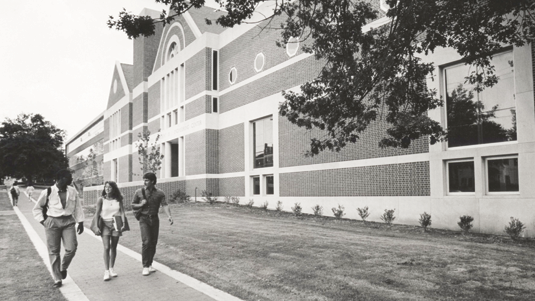 [Continued]
[Continued]
ENROLLMENTS GROW IN THE ’80s AND ’90s
During the 1980s, 19 percent of all Auburn graduates received degrees in engineering, second only to the business college. Combined, the two colleges accounted for 42 percent of all graduates, compared with 33 percent during the 1970s. While the College of Engineering emphasized research and postgraduate education under Weaver and Walker, undergraduate education remained the key mission and represented the majority of its students.
In June 1993, Larry Benefield, who was named by Walker as associate dean for academics, noted that the college had grown to the point where it was tenth in the number of bachelor’s degrees produced in the nation, and fifteenth in enrollment at the undergraduate level.
However, the college sought quality as well as quantity. With only 20 percent of the student body, engineering students represented 40 percent of Auburn’s honor students during the 1992 academic year, a trend which has continued to grow, even today. With engineering starting salaries among the highest for new college graduates, and with a strong outlook for employment in most areas, the pipeline of engineering applicants grew.
“Auburn had begun to develop a reputation as one of the premier engineering institutions in the Southeast,” said Benefield, adding, “We were beginning to develop a national presence, something we had already accomplished to a significant extent in our research programs.”
Like his predecessors, Walker was faced with funding problems that he felt compromised Auburn’s plans to move the college to greater recognition as one of the nation’s best programs. However, unlike them, he was much more aggressive in seeking private financial support.
At the beginning of his administration, only 1,216 of Auburn’s 26,000 engineering alumni contributed to the college; they gave a bit more than $300,000, not including another $1.1 million in corporate support. By the end of the 1990 academic year, just two years into his administration, donations to the College of Engineering increased to $2 million, including $660,000 from alumni and friends.
With increasing private support and ongoing engineering construction, the perennial issue of engineering accreditation faded into the background. ABET, the accreditation board for engineering and technology, visited campus to review five curricula in August 1989, and in August 1990, reaccredited all five for an additional three years.
The accreditation agency noted in its report that “a great deal has been done to improve the engineering programs at Auburn University since the last visit in 1986.” They also wrote, “new construction and renovations have improved the laboratory and classroom space problems in most departments, and new computer and other laboratory equipment have been acquired.”
[miniflickr photoset_id=72157627977012296&sortby=date-posted-asc&per_page=20]